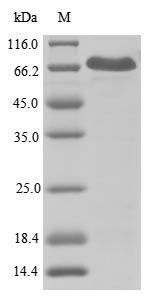Amino acids 1-536 form the expressed segment for recombinant Human NLRP3. The calculated molecular weight for this NLRP3 protein is 66.1 kDa. The NLRP3 protein was expressed in e.coli. Fusion of the N-terminal 6xHis tag into the NLRP3 encoding gene fragment was conducted, allowing for easier detection and purification of the NLRP3 protein in subsequent stages.
The human NACHT, LRR, and PYD domains-containing protein 3 (NLRP3) mainly serves as a critical component of the inflammasome, a multiprotein complex involved in immune responses. NLRP3 activation leads to the cleavage and release of pro-inflammatory cytokines, triggering inflammation in response to cellular stress or pathogens. In immunology and inflammatory research, studying NLRP3 provides insights into innate immunity, inflammatory pathways, and autoimmune diseases. NLRP3's involvement in various pathologies, including neurodegenerative disorders and metabolic diseases, makes it a target in diverse research areas. Investigating NLRP3 offers potential applications in understanding and modulating immune responses, inflammation, and related diseases.






